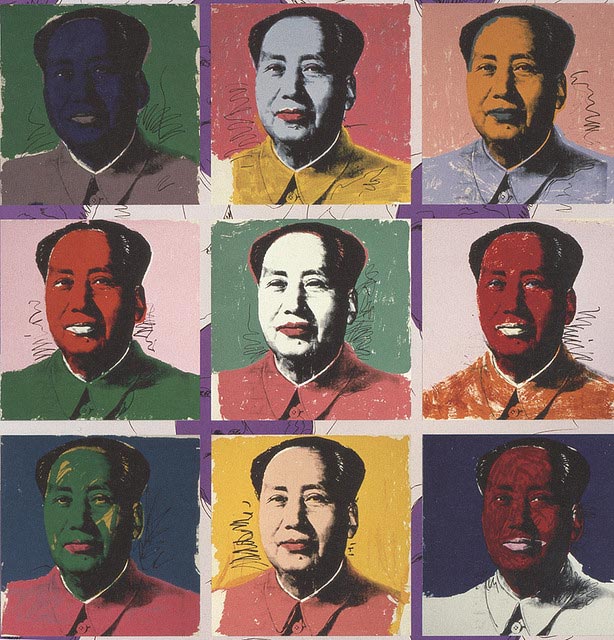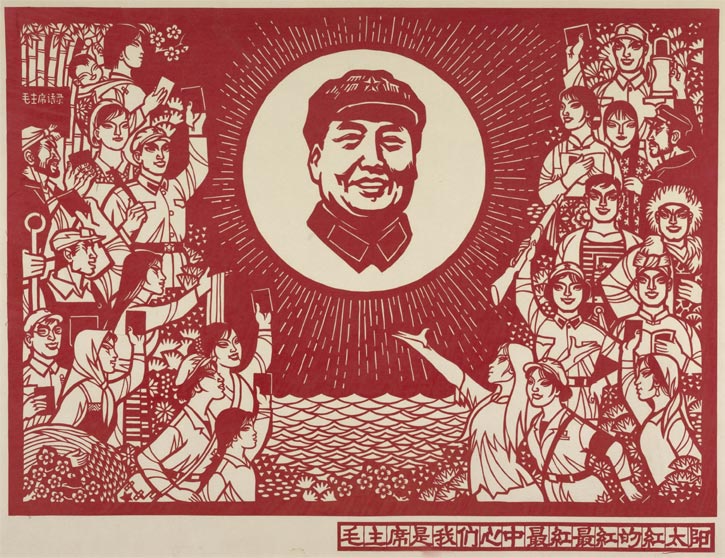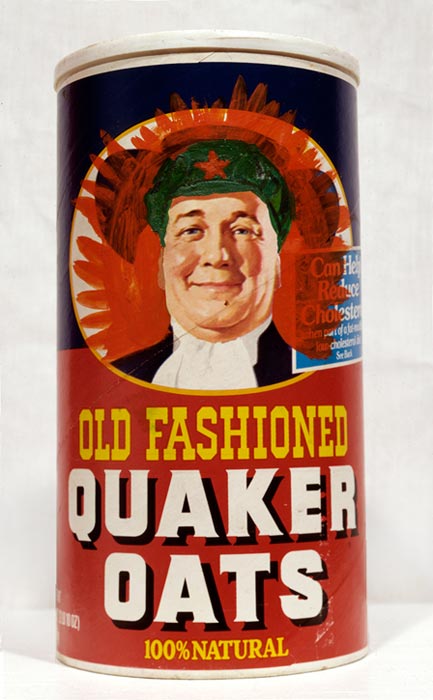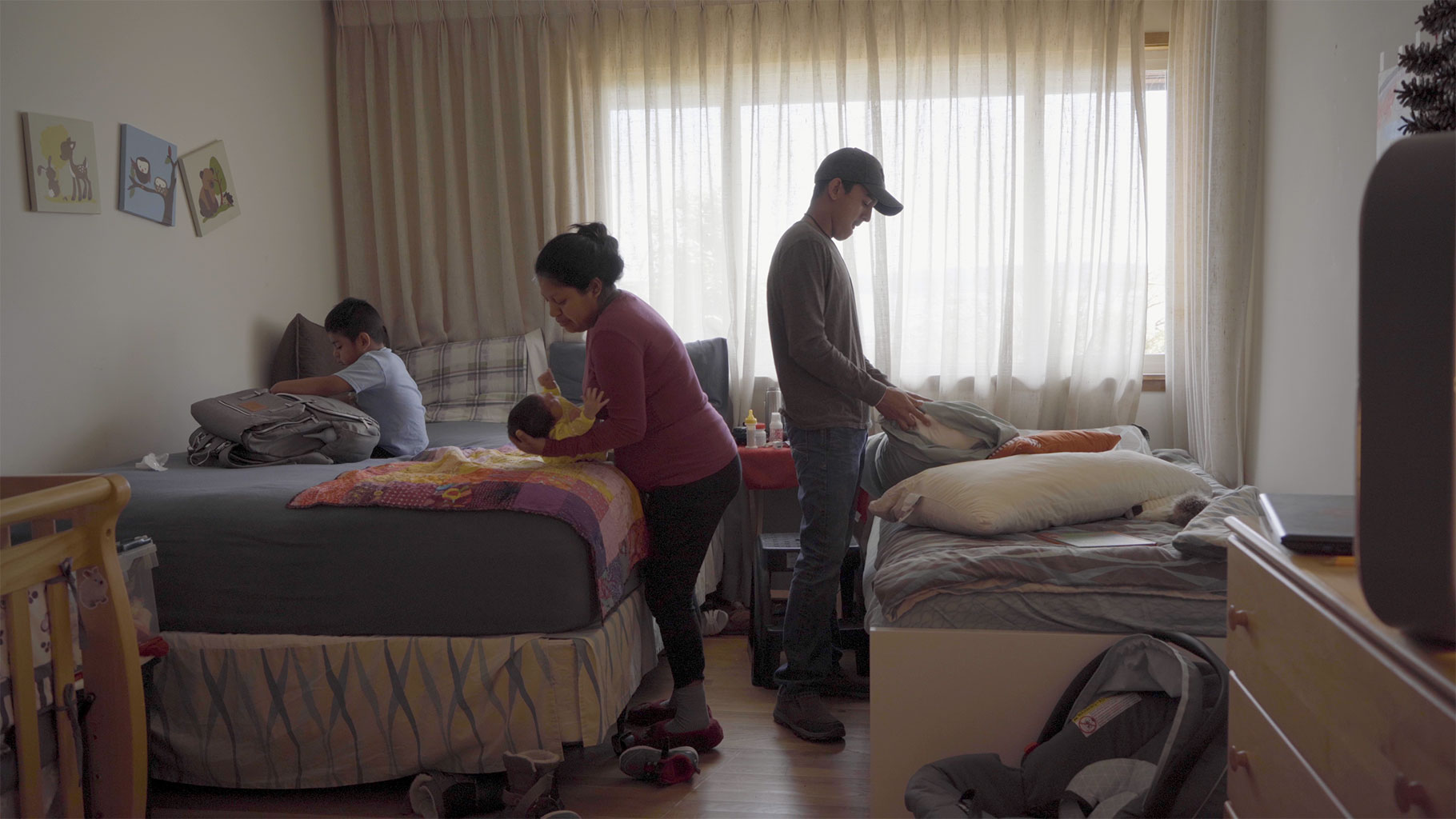
Andy Warhol included Mao in his collection of silkscreened works in 1972. Since then, many artists have followed in his footsteps to reimagine the dictator’s face and place. In this post is a mix of classic images of China’s Mao Zedong, alongside new interpretations of his distinguished mug and some philosophical ramblings.
OLD _ a paper-cut propaganda poster discovered by the University of Michigan’s Center for Chinese Studies. SEE MORE IN HI-RES

NEW _ Mao Money 8 by David Foox. SEE LARGER IMAGE

David Foox
David Foox might envision a future where economic differences between the United States and China might be settled by an international currency. About Mao Money 8 and Mao’s influence, he states: “It is clear to me that Chairman Mao was a truly iconic leader and his image is a larger than life representation of forces and factors that have helped shape the modern era. My artwork titled “Mao Money 8″ was a re-visualization of future US Currency and as part of that notion, I included both the concept of a world currency and a US currency backed by Chairman Mao. It is a commentary on the ever changing notion of money – and who knows we may all see the day where there is an international currency based entirely in the digital world.” You can learn about the full symbolism behind the piece HERE.
—
OLD _ Portrait of Portrait of Mao Zedong at Tiananmen Gate

NEW

Marko
Marko Koeppe is one artist who became interested in Mao Zedong after seeing Warhol’s Mao.
As a German artist, Koeppe holds strong opinions about borders and walls; he hopes that his art, including his incorporation of Mao’s image, can transcend those boundaries.
“The [Berlin] Wall is standing (for me) as a border, not to think outside your world view. To be limited [by] your horizon… is something that is all the same with dictators and similar systems. If you wanna go deeper, it’s the same with all human beings here,” Koeppe says. “Everyone has got his own horizon, and most of us do not want to be disturbed [by outside influences]… I’m making pictures for the ones that want to be disturbed, that want to extend their horizon. Everything develops in the eyes of the viewer – (so open your mind).”
—
OLD

NEW _ Representation of an Idea to the Outside by Ever

Ever
Argentinian street artist Ever works a great amount with Mao’s image and has thought quite deeply and extensively about the subject. At the very heart of his work is his desire to talk about what he calls the “human contradiction.”
“In a capitalist society, the volume of information available to us affords us an incredible degree of choice in what we want to consume. However, when faced with the sheer number of options, we often end up overwhelmed and unsure about our own objectives. So, though happy to buy into the appealing illusion of freedom offered by capitalism, we ironically find ourselves frequently plagued with the paralysis of indecision and distracted from our own ideological desires with constant material craving[s]. To illustrate this contradiction we have only to consider the current youth generations in the western world. They find themselves at their peak and with the whole world within reach, but paradoxically they often feel stagnant and impotent, temporarily satiating themselves with a new iPod or car while battling disillusionment in a failing system which can no longer fulfill the promise of a bright future. Despite this dilemma, Western society defends its system with conviction when faced with other options, like that of Communism. China is a country long exposed to Communism while Western society [has] demonized it, but all are now involved in the same economic system. China gave up true Communism long ago and is now the creator of the majority of the products used in modern day capitalism to satisfy our most immediate and shallow needs.
Often when we defend our systems against those that we think threaten them, in reality we are only defending outdated ideologies which are no longer truly embodied by our current political systems. To reveal these contradictions, I have chosen to utilize the images of Chineses Posters for describe Mao Tse Tung and the Chinese culture. When I see [those] posters, you see [the] progress of an idea, but on the facts at this time, you see a bad ending.”
—
OLD

NEW

David Szauder
When glitch artist David Szauder decided to explore how glitch art could be combined with iconic imagery, his mind went directly to Mao — an individual that, for him, provided “direct connection to pop art.” Perhaps it as the callback to Warhol that made this connection, but working with Mao has led Szauder one step further, to contemplate the relationship between pop art and glitch art. Nonetheless, despite the bright colors and fanfare, Szauder’s impressions of Mao are less than positive. “I am coming from an ex-Communist country. I have total bad feelings about Mao, because the blood [is] on his hand[s], but visually… I [see how] the idealistic images from that era [are] totally [controversial],” he says.
Read David Szauder’s complete statement
—
OLD _ Urgently Forge Ahead and Bravely Advance with Great Leader Chairman Mao (Jin gen weida lingxiu Mao Zhuxi fenyong qianjin!), 1971

Hongtu Zhang
On Long Live Chairman Mao and about his Mao-related series, Material Mao, Zhang bluntly says, “I believe in the power of the image, but I don’t believe in the authority of the image. If you stare at a red shape for a long time, when you turn away, your retina will hold the image but you will see a green version of the same shape. In the same way, when I lived in China, I saw the positive image of Mao so many times that my mind now holds a negative image of Mao. In my art I am transferring this psychological feeling to a physical object.”
In a sarcastic and joking tone, Zhang downplays the importance of his ethnic heritage by continuing, “Sometimes the hole in my work might remind you of the Nothingness of Taoism or the negative space of traditional Chinese ink painting, but the visual inspiration of my work comes directly from a bagel.”
In reality, though, China’s influence — and subsequently Mao’s influence — continue to have an impact upon his life. In a public talk, he was quoted with the following:
“Mao followed what Karl Marx said: “Religion is the opium of the people”. After he took power, all religions were banned in China. During the Cultural Revolution, anything that had any religious meaning, such as books, statues, portraits… were destroyed. As a result, Mao created a huge vacuum of belief, and at the same time, he used his power and all the propaganda tools including literature, art, music… to make himself a new religious icon.
It was a hot late summer day in 1966, when I went to a rally at the Central Academy of Drama in Beijing. Around a thousand students sat on the ground of a sports field. Suddenly, I heard someone yell: ” Beat, beat this counterrevolutionary, he dares to sit on our great leader Chairman Mao’s portrait!” That student was beat-up by at least 10 people, and blood was all over his body. In reality, he was only sitting on a newspaper. But Mao’s portrait was printed on every single newspaper, every single day.
It was a lesson that showed me how powerful and how terrifying an image can be when it becomes a religious icon.
Like everyone in my generation, at the beginning of the Culture Revolution, I had complete trust in Mao. Some writings in his Red Book were so romantic, so idealistic. But ironically, the CR and Mao himself made me change my mind. I saw people dividing into different groups, fighting and killing each other, but everyone including the killers and the victims declared they were on the side of Mao’s revolution. I felt that all of the young people, including myself were fooled and used by Mao.
After I left China and moved to the States in 1982, I tried to forget everything that happened in China by doing so called “pure art”. I hated any political content in art. But I just couldn’t erase Mao’s image from my mind.”
END.








This article is money. FOLLOW
[…] about the recycling of Maos portraits. I got in and made a kind of statement. And she made a nice article but i feel important to add some feedbacks afterhand: – the pop art line in my work is not that […]